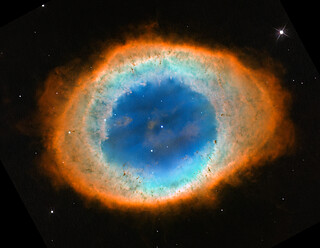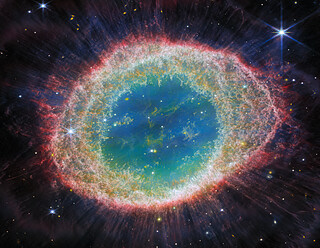Webb and Hubble’s views of the Ring Nebula
[Right] The NASA/ESA/CSA James Webb Space Telescope has observed the well-known Ring Nebula with unprecedented detail. Formed by a star throwing off its outer layers as it runs out of fuel, the Ring Nebula is an archetypal planetary nebula. Also known as M57 and NGC 6720, it is both relatively close to Earth at roughly 2,500 light-years away. The new images, taken by Webb’s NIRCam (Near-InfraRed Camera), provides unprecedented spatial resolution and spectral sensitivity.
Credit: ESA/Webb, NASA, CSA, M. Barlow, N. Cox, R. Wesson
[Left] This image from the NASA/ESA Hubble Space Telescope of the Ring Nebula was released in 2013 and has since become one of the observatory’s most well-known images. From Earth’s perspective, the nebula looks roughly elliptical. However, astronomers combined ground-based data with observations by Hubble to explore the object’s structure, evolution, physical conditions and motion. This research revealed that the nebula is shaped like a distorted doughnut.
Credit: NASA, ESA, and C. Robert O’Dell (Vanderbilt University)
Credit:NASA, ESA, and C. Robert O’Dell (Vanderbilt University)
About the Images
| Id: | weic2320b | |
|---|---|---|
| Release date: | 21 August 2023, 16:00 | |
| Related releases: | weic2320 | |





